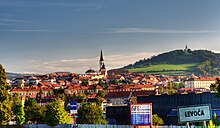 Global Information
Global InformationZipser Germans information
German: Zipser, Zipser Deutsche, and/or Zipser Sachsen | |
|---|---|
 Levoča (German: Leutschau), one of the former historical centres of the Zipser Germans in Slovakia | |
| Regions with significant populations | |
| Slovakia and Romania (more specifically in present-day Suceava County, Bukovina, northeastern Romania as well as Maramureș in northern Transylvania) | |
| Languages | |
| German (with the Zipser German dialect) | |
| Religion | |
| Roman Catholicism and Evangelical Lutheranism | |
| Related ethnic groups | |
| Germans, Germans of Romania (including, most notably, Transylvanian Saxons and Bukovina Germans), German diaspora, Austrians, Flemings, or Luxembourgers | |
Native to Central-Eastern Europe, more specifically to present-day Spiš region, north-eastern Slovakia (since the High Middle Ages onwards) as well as Bukovina and Maramureș, Romania (since the Modern Age onwards). |
The Zipser Germans, Zipser Saxons, or, simply, just Zipsers (German: Zipser[1] or Zipser Deutsche, Romanian: Țipțeri, Hungarian: Cipszer, Slovak: Spišský Nemci) are a German-speaking (more specifically Zipser German-speaking as native dialect) sub-ethnic group in Central-Eastern Europe and national minority in both Slovakia and Romania (there are also Zipser German settlements in the Zakarpattia Oblast, in the historical region of Carpathian Ruthenia, present-day western Ukraine).[2] Along with the Sudeten Germans (German: Sudetendeutsche), the Zipser Germans were one of the two most important ethnic German groups in the former Czechoslovakia. An occasional variation of their name as 'Tzipsers' can also be found in academic articles.[3] Former Slovak President Rudolf Schuster is partly Zipser German and grew up in Medzev (German: Metzenseifen).[4]
The Zipser Germans were previously native to the Szepes County (German: Zips; Slovak: Spiš, Hungarian: Szepes) of Upper Hungary—today mostly north-eastern Slovakia—as that region was settled by colonists from present-day central Germany (and other parts of contemporary Germany) during the High Middle Ages, more specifically beginning in the mid 12th century, as part of the Ostsiedlung.[5] Beginning in at least the 18th century, many members of this German ethnic sub-group migrated to southern Bukovina,[6][7] Maramureș, Transylvania, and in the mountainous Banat (all of the aforementioned regions situated in contemporary Romania).[8] Most of the Zipser German community in Romania lives in Maramureș County and across the Rodna Mountains respectively.
Occasionally, Zipser Germans are also referred to as Zipser Saxons (Hungarian: szepesi szászok or szepességi szászok, German: Zipser Sachsen), a name stemming from their geographic origin of initial settlement during medieval times corresponding to the present-day Spiš (German: Zips) region situated in north-eastern Slovakia. The county (German: Komitat) where they settled in the beginning is known in Hungarian as 'Szepes'.[9] Alongside the Transylvanian Saxons in Transylvania, contemporary central Romania, and the Baltic Germans from Estonia and Latvia, the Zipser Germans are one of the three oldest German-speaking and ethnic German groups in Central and Eastern Europe, having continuously been living there since the High Middle Ages onwards.[10]
The Zipser Germans can also be equated with the Germans of Slovakia (German: Slowakeideutsche) and are part of the broader group of Carpathian Germans (German: Karpatendeutsche), having chiefly been referred to as such along with the Germans of Carpathian Ruthenia since the end of World War II onwards. They are also part of the Germans of Romania. The small community of Zipsers still living in Suceava County, southern Bukovina, Romania, can be perceived as part of the Bukovina German community as well, in the greater sense that is.[11]
- ^ Democratic Forum of Germans in Romania, Oberwischau/Vișeu de Sus branch. "Demokratisches Forum der Deutschen in Oberwischau" (in German). Retrieved 14 January 2023.
- ^ Scridon Ioana, Oana-Ramona Ilovan (March 2016). "Approaching the Other in the Zipser Community Identity Issues and Methodological Insights into Geographical Cross-Cultural Research". Transylvanian Review. Retrieved 17 April 2023.
- ^ Radu Săgeată; Mircea Buza; Traian Crăcea (2017). "The Germans in Romania, with special regard to the Transylvanian Saxons" (PDF). Mitteilungen der Österreichischen Geographischen Gesellschaft. Retrieved 20 April 2023.
- ^ Friedrich Gottas. "Sachsen (Zips)". Alpen-Adria, Universität Klagenfurt (in German). Retrieved 22 June 2020.
- ^ Karl Julius Schröer, Die deutschen Mundarten des ungrischen Berglandes (1864)
- ^ Oskar Hadbawnik, Die Zipser in der Bukowina (1968) discusses the Zipserfest held in Jakobeny in 1936 to commemorate 150 years since the Zipsers migrated to Jakobeny in 1786.
- ^ І. Я. Яцюк, Тернопільський національний педагогічний університет ім. Володимира Гнатюка, Наукові записки. Серія “Філологічна”, УДК 81’282.4:811.112.2(477): Lexikalische Besonderheiten Deutscher Dialekte in Galizien und der Bukowina: “Die Siedler in den ursprünglichen Bergwerksgemeinden im Südwesten der Bukowina sprachen Zipserisch und zwar Gründlerisch, wie es in der Unterzips gesprochen wurde. Dabei wurde [v] im Anlaut wie [b] ausgesprochen: Werke – berka, weh – be, Schwester – schbesta. Anlautendes [b] wurde zu [p]: Brot – prot, Brücke – prik.”
- ^ Jacob Steigerwald, Tracing Romania's heterogeneous German minority (1985), page 8
- ^ "Szepes County". Donau Schwaben USA. Retrieved 14 January 2023.
- ^ Victor Rouă (14 January 2023). "The History Of The Zipser Germans In Central Europe". The Dockyards. Retrieved 19 February 2023.
- ^ Sophie A. Welsch, Ph.D. (March 1986). "The Bukovina-Germans During the Habsburg Period: Settlement, Ethnic Interaction, Contributions" (PDF). Immigrants & Minorities, vol. 5, no. 1. Retrieved 17 April 2023.